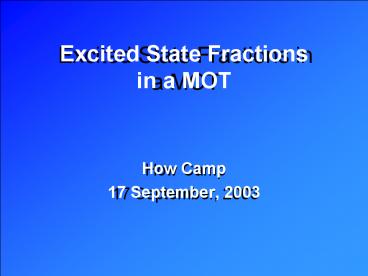Excited State Fractions in a MOT - PowerPoint PPT Presentation
1 / 18
Title:
Excited State Fractions in a MOT
Description:
Excited State Fractions in a MOT. Excited State Fractions in a MOT. How ... Then How Do We Find f ? ... p. r. p. Chopping Our Lasers. Chopping Our Lasers ... – PowerPoint PPT presentation
Number of Views:40
Avg rating:3.0/5.0
Title: Excited State Fractions in a MOT
1
Excited State Fractions in a MOT
Excited State Fractions in a MOT
- How Camp
- 17 September, 2003
How Camp 17 September, 2003
2
Er, Whats a MOT?
Er, Whats a MOT?
3
Why Do We Care About f ?
Why Do We Care About f ?
- Understand Initial Conditions
4
How Would We Do It?
How Would We Do It?
5
So, Whats the Problem!?
So, Whats the Problem!?
6
So, Whats the Problem!?
So, Whats the Problem!?
Beam Symmetry?
I2 0.45 mW / cm2
B-Field Gradient?
I1 0.50 mW / cm2
7
Then How Do We Find f ?
Then How Do We Find f ?
8
How Do We Find f ?
How Do We Find f ?
TAC Spectra
Q Value Spectra
7KeV Na Rb(5s), Rb(5p)
9
How Do We Find f ?
How Do We Find f ?
Ason ? ?s nson Ton
Asoff ? ?s nsoff Toff
10
How Do We Find f ?
How Do We Find f ?
nson npon nsoff
11
The Detuning Experiment
The Detuning Experiment
The Goal Measure Excited State Fraction as a
Function of Detuning
12
MOTRIMS Experimental Setup
MOTRIMS Experimental Setup
13
Preliminary Results
Preliminary Results
14
Whats Next?
Whats Next?
- Careful Comparison to Theory For f
- Look at Different Intensities
15
(No Transcript)
16
(No Transcript)
17
How Do We Measure Q Value ?
How Do We Measure Q Value ?
q
Q energy defect ? Scattering angle (Lab
frame) Pr , Pr? parallel and perpendicular
recoil momentum components PP , PP projectile
momentum before and after the collision Vp
projectile velocity nc number of transferred
electrons
18
Chopping Our Lasers
Chopping Our Lasers

